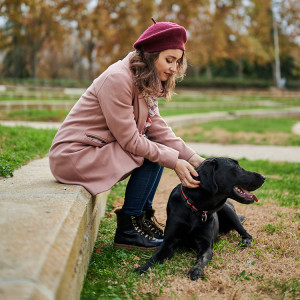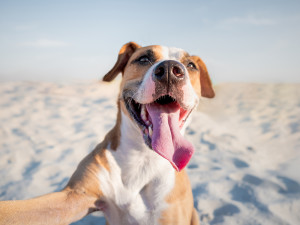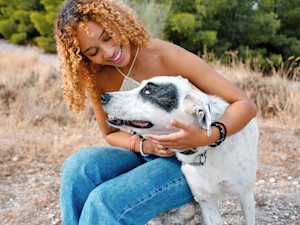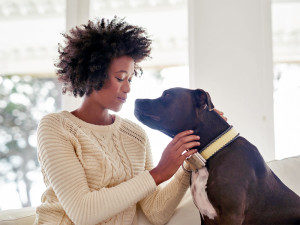Why Is Your Dog Side-Eyeing You? Learn What This Means
It’s kind of goofy, but there may actually be a reason they’re doing it.

Share Article
In This Article:
What Is Dog Side-Eye? Reasons for Dog Side-Eye What to Do When Your Dog Shows You Side-Eye When to Consult a Vet
Just because people and dogs don’t speak the same language doesn’t mean dogs don’t have a language. They do — and it is most often expressed through their bodies.
We expect dogs to understand the words we teach them so they will know what we want. Similarly, dogs have the right to expect us to learn their language to understand their needs and desires. One interesting aspect of dog body language is the action of side-eyeing you. Also known as whale eye, this look can represent various emotions and intentions. A dog parent should try to understand this dog expression and learn how to react.
If you’ve never encountered or understood canine “side-eye” or “whale eye,” read on to learn all about them. Having a full understanding of these behaviors can help you ensure your dog is healthy and happy.

What is dog side-eye?
When dogs give you the side-eye, they are glancing sideways without turning their heads. When they do that, the sclera (the white part of the eye) appears crescent-shaped, which is why it’s also called a whale eye. Whales do that when they are stressed or alarmed. Likewise, dogs are feeling uneasy, stressed, or overly alert when they give you the side-eye.
What is whale eye?
Whale eye is another name for a dog’s side-eye because whales also have more noticeable scleras when stressed or alarmed. This look is subtle but a very powerful part of dogs’ body language. It lets you know their feelings without barking or other more obvious behaviors. Depending on the situation, this look often serves as a warning sign.
How to differentiate side-eye from other looks
The side-eye is just one element in a dog’s repertoire of body language signs. Others involving the eye, include:
Relaxed gaze: indicating contentment or calmness
Direct stare: which can mean curiosity, attention, or assertiveness
Squinting eyes: suggesting relaxation or submission, depending on the situation
How do you tell the difference between these eye appearances and their possible meanings? You need more information and can get it by observing your dog’s body posture, tail position, and overall demeanor. For example, a relaxed tail can signal playful intent when accompanying a side-eye, while a stiff tail and tense body suggest stress or discomfort.
Main reasons for dog side-eye
A dog can give you the side-eye for various reasons. To understand why, consider other signs such as body posture, environmental context, and accompanying behaviors.
A dog’s body language cue
The side-eye is a fairly common element in canine body language. Dogs can experience many different feelings just like us, and they use their bodies to “speak” without vocalizing. Some of these feelings include stress, discomfort, or vigilance.
Fear or anxiety
When a dog is stressed by loud noises, unfamiliar people, or other dogs, the side-eye may be part of their nonverbal communication. Other signs, such as lowered body posture, tucked tail, or panting, may accompany it.
Fearful side-eye is often an early cue, giving a warning before progressing to more aggressive behavior. If a dog feels trapped, they may give the side-eye and retreat if they can, instead of attacking. This is an example of how side-eye behavior can help you determine what’s bothering your dog, so you can intervene before the situation escalates.
Understanding fear-based behaviors also helps prevent accidental reinforcement of their anxiety. Instead of comforting your dog in a way that validates their fears, work on creating a calm environment that encourages confidence.
Misbehavior or playfulness
There are times when your dog will give you side-eye out of playfulness. This can happen during tug-of-war or when your dog is stealing your sock. In these cases, it is often paired with the body language of a wagging tail or playful posture. This can happen not just with young dogs but with seniors as well.
Curiosity
Dogs are inquisitive creatures. They want to know what you are doing most of the time. They will side-eye you just because they’re curious. Their body language will be different if it’s just curiosity. Ears will be perked, and they will have a relaxed stance. This occurs especially at mealtime or if you’re opening a package. This behavior illustrates their cognitive abilities and an interest in their surroundings. Encouraging their curiosity through games and puzzles will contribute to their mental abilities and overall happiness.
Pain or discomfort
Dogs may communicate pain or discomfort by giving you the side-eye. This may be accompanied by whining, limping, or changes in sleeping habits or eating. In cases of pain or discomfort, side-eye may be a sign they don’t want you to touch a particular area of their body, or they don’t want any physical contact.
A pet parent should also watch for subtle signs, such as excessive licking of a particular spot or changes in posture. These can be clues that something is bothering their dog.
Vision issues
Naturally, side-eye could also indicate something is wrong with your dog’s vision, such as your dog’s peripheral vision being stronger. If your pup hesitates to look directly at you, and if other symptoms occur, you should have your veterinarian check their eyes.
Cataracts are common in dogs, who can also experience glaucoma and retinal disorders. They may suddenly start bumping into furniture, not see as well in low-light conditions, or show general disorientation when they walk around the house. Early diagnosis can prevent further complications.
Vision disorders may be more of a problem with certain breeds, such as Collies or Australian Shepherds. Knowing the types of ocular disorders that are more common in your dog can help alert you to the signs and symptoms of possible problems.
Neurological issues
If your dog has excessive side-eye, you should see your vet because that can indicate a neurological condition. Other symptoms will usually accompany this, such as seizures, head tilting, or uncoordinated movements. If you have a senior in particular, watch for neurological problems, as they are more common in older dogs.
What to do when your dog shows you a side-eye
When your dog gives you side-eye, the appropriate response will depend on the underlying cause. The rest of your dog’s body language will provide additional cues. Here are a few ways to help your pet.
Build trust and comfort
If fear or anxiety is the reason for the side-eye, focus on:
Creating a safe and supportive environment
Providing reassurance through gentle petting, calm tones, and predictable routines
Engaging in activities your dog enjoys, such as walks or interactive play — positive experiences that strengthen your bond and help ease your dog’s anxiety over time
Using tools like calming sprays or pheromone diffusers to create a stress-free environment, especially during loud events, such as fireworks
Help them with training and socialization
Proper training and socialization can decrease bad behavior and make your dog feel more secure. Here are a few ways to achieve this.
Positive reinforcement (or rewards-based) techniques are beneficial for teaching appropriate responses to various situations.
Socialization with other dogs and exposure to new environments can also decrease the chance of fear-based side-eye. Begin slowly, rewarding your dog for good behavior in new situations.
Keep training sessions short but consistent, so they don’t lose focus.
Never punish your dog if they give you side-eye, regardless of the reason. Punishment only makes things worse.
Determine if the causes are medically related or not
If your dog gives you side-eye frequently and there are accompanying symptoms, keep a journal and take it with you to the vet. If side-eye behavior is paired with signs of pain, vision issues, or neurological symptoms, it may be medically related. In this case, your dog needs to be seen by your vet immediately.
Medical evaluations may include eye exams, neurological assessments, or imaging tests to rule out underlying conditions. Early diagnosis is key to effective treatment.
When to consult a veterinarian
Knowing when your dog’s side-eye might warrant professional attention is essential. Consult a veterinarian if they exhibit any of the following symptoms.
The side-eye is frequent and accompanied by signs of discomfort, pain, or stress.
There are changes in your dog’s vision or unusual eye movements.
Neurological symptoms like head tilting, unsteady gait, or seizures appear.
During your veterinary visit, be prepared to describe the context in which the side-eye occurs and any other behavioral or physical changes you’ve noticed.
A detailed veterinary exam may uncover issues that aren’t immediately obvious. Depending on your dog's symptoms, blood tests, imaging, or specialist consultations might be recommended.
Bottom line
Side-eye, also known as whale eye, is a way for your dog to move their eyes without turning their head.
It is a method of communication that alerts you to how your dog may be feeling and can mean various things.
It’s vital to learn what it means and observe your dog frequently. They need you to react the proper way to make them feel better.
A medical condition can sometimes cause side-eye in dogs. If your dog has additional symptoms, it’s time to see your vet.
References
“Dog Body Language Basics.” PennVet, Ryan Hospital, www.vet.upenn.edu/docs/default-source/ryan/ryan-behavior-medicine/dogbodylanguagebasics-(pdf)opens in new tab.
“Dog to English Translation Chart.” academics.lmu.edu, Loyola Marymount University, academics.lmu.edu/media/lmuacademics/cures/urbanecolab/module09/Dog%20Body%20Language.pdfopens in new tab.
Hasegawa, Masashi, et al. “Dogs’ Body Language Relevant to Learning Achievement.” Animals, vol. 4, no. 1, 27 Feb. 2014, pp. 45–58, https://doi.org/10.3390/ani4010045opens in new tab.

Dr. Shelby Neely, DVM
Dr. Shelby Neely is a freelance writer and veterinarian who graduated from the University of Pennsylvania School of Veterinary Medicine and has practiced veterinary medicine for 30 years, specializing in small animals. Her work has appeared in Allivet, AsktheCatDoctor, WhiskerDocs, Ask the Cat Doctor Radio, Ask the Cat Doctor TV, and numerous other websites, brochures, newsletters, newspapers, and ebooks. In her spare time, Dr. Neely likes to spend time with her three children, two grandchildren, three cats, two grand-cats, and five grand-dogs.
Related articles
![Dog in the sand smiling at the camera]()
Can Dogs Smile?
There’s a big difference between a dog smiling and showing their teeth.
![Woman hugging her dog outside.]()
Your Dog Can Understand Your Facial Expressions, Study Says
And they love it when you smile.
No, Your Dog Does Not Feel Guilt—Here’s What Those “Regretful” Looks Really Mean
Your pup doesn’t actually feel bad about eating your pizza.
Why Does My Dog Stare at Me? Possible Reasons and What to Do
Beyond the fact that they’re your biggest admirer.





